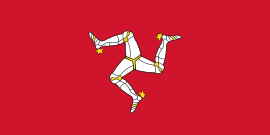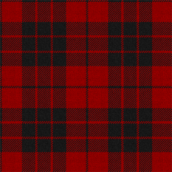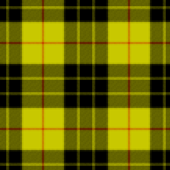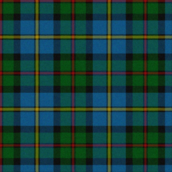Clan MacLeod of Raasay facts for kids
Clan MacLeod of Raasay is a Highland Scottish clan. A clan is like a large family group, often with a shared history and a chief. This clan once owned a lot of land on the Isle of Raasay and the west coast of Scotland.
For a long time, from the 1300s to the early 1600s, there were two main groups of Macleods. These were the MacLeods of Dunvegan and Harris (known as Clan MacLeod), and the Macleods of Lewis. In Gaelic, the Macleods of Lewis were called Sìol Thorcaill, meaning "Seed of Torquil". The MacLeods of Dunvegan and Harris were called Sìol Thormoid, meaning "Seed of Tormod".
The Macleods believe their family started with a man named Leod. He was traditionally thought to be a son of Olaf the Black, who was a king of Mann and the Isles. Leod was said to have two sons: Tormod and Torquil. Tormod's family became the Macleods of Harris and Dunvegan. Torquil's family became the Macleods of Lewis.
In the 1500s and early 1600s, the main family line of the Macleods of Lewis almost ended due to family fights. This led to the clan losing their lands to the Clan Mackenzie. However, one part of the family, the Macleods of Raasay, survived. They continued to live on their lands for many centuries. The current Chief of the Macleods of Raasay is Roderick John Macleod. He is the 18th Chief and lives in Tasmania, Australia.
Today, the Clan MacLeod of Raasay, along with the Macleods of Lewis and Clan Macleod, are part of the "Associated Clan MacLeod Societies". This group includes ten national societies around the world. These are in Australia, Canada, England, France, Germany, New Zealand, Scotland, South Africa, the United States of America, and Switzerland.
Contents
Clan Beginnings

The Story of Olaf the Black
The official story of the Macleod clan is that they came from a man named Leod. He was born around the year 1200. People traditionally believe that Leod's son, Tormod, started the Macleods of Harris and Dunvegan. His other son, Torquil, started the Macleods of Lewis.
The idea that they came from Olaf the Black might have started in the 1600s. A chief named Iain Mor MacLeod was called "John McOlaus" in a document from 1630. Later, his son Iain Breac was likely the first Macleod to use the coat of arms of the Kings of Mann. This was because the Macleods believed they were related to King Olaf of Man.
The Macleods of Lewis
The first mention of the Macleods of Lewis was in a royal document from the time of David II King of Scots (1329–1371). This document gave land in Assynt to Torcall Macleod around 1343. By 1344, the Macleods of Lewis controlled the Isle of Lewis. They were under the powerful Macdonalds of Islay. Over time, the Macleods of Lewis became very strong. They owned lands in Lewis, Raasay, Waternish on Skye, and parts of the mainland like Assynt, Coigach, and Gairloch.
How the Clan Lost Lewis
The Macleods of Lewis lost their power and the Isle of Lewis because of family conflicts. A chief named Ruairi had a son, Torquil Connanach. Around 1566, Torquil Connanach fought his father, Ruairi. He was supported by the Mackenzies and held Ruairi prisoner.
Ruairi later had two more sons, Torquil Dubh and Tormod, with his third wife. Ruairi made Torquil Dubh his new heir. Again, Torquil Connanach fought back with the help of the Mackenzies. Ruairi was captured again, and many of his men were killed. After Torquil Connanach's victory, all the land documents for Lewis went to the Mackenzies. Ruairi was freed later and ruled Lewis peacefully until his death in 1596.
After Ruairi's death, Torquil Dubh became the chief. In 1596, Torquil Dubh attacked the lands of Torquil Connanach and the Mackenzies. He was then declared a rebel by the government. Torquil Dubh was eventually captured and killed in 1597. His younger sons and his brother Niall continued the fight. They were helped by the Macleods of Harris and the Macleans.
Because the Mackenzies had the land deeds, the Scottish government took control of Lewis in 1597. They tried to set up new settlements on the island. Niall Macleod and his nephews hid on Bearasay island. They fought against the Mackenzies for almost three years before being forced to leave. With the end of the Macleods of Lewis's main line, the title "Lord Macleod" went to the Mackenzie Earls of Cromartie. However, the leadership of the Macleods of Lewis passed to the Macleods of Raasay. They still hold this position today.
Clan History
The 1500s
The Macleods of Raasay come from Malcolm Macleod IX of Lewis. Around 1510, he gave the islands of Raasay and Rona to his second son, Malcolm Garbh. He also gave him lands on the mainland called Coigeach and Gairloch. Malcolm Garbh Macleod (1503–1560) was the first Macleod of Raasay.
In 1549, it was noted that Raasay belonged to Mac Gillechalum (Malcolm Garbh) by force. Malcolm Garbh had at least two sons, Alexander and John. John was known as Iain na Tuaighe, or "John of the Axe." He married his uncle's wife, Janet. John and Janet had several sons and a daughter. Sadly, the sons died in a terrible event on Isay island.
Malcolm Garbh's son, Malcolm Og, became the Laird of Raasay during his father's lifetime. He received a Royal Charter for his lands in 1596. Malcolm Og died in a fight in Clachan Bay, Raasay, on August 11, 1611. Several Mackenzies were also killed in this fight.
The 1600s
John Garbh, the 7th Chief (1625–1671), was known for his great size and strength. He became chief in 1648. He drowned in the Minch sea in 1671 while returning from Lewis. John Garbh was likely the last chief to live in Brochel Castle.
Brochel Castle was probably built in the late 1400s or early 1500s. It was in a very important spot for controlling sea routes. It looked out over the Inner Sound, which was a valuable area to control back then.
The 1700s
The Jacobite Uprising (1745–1746)
Malcolm, the 10th Chief (1691–1761), supported the Jacobite cause. The Jacobites wanted Prince Charles Edward Stuart (Bonnie Prince Charlie) to be king. Malcolm, his son Dr. Murdoch Macleod, and his cousin Captain Malcolm Macleod joined the Prince with 100 men. The Chief had wisely given his estate to his eldest son, John. This way, the Raasay estate would stay in the family, no matter what happened in the uprising. After the Battle of Culloden, Malcolm returned to his estate with some of his men.
Because Macleod of Raasay supported the Jacobites, government troops came to Raasay. They destroyed Raasay House and burned every house on the island. They took all the cattle, horses, and sheep. Even the boats were taken away.
After the Battle of Culloden, Prince Charles Edward Stuart hid in the Highlands and Islands. There was a huge reward of 30,000 pounds for his capture. Prince Charles hid on Raasay for two days. But he thought the island was too small to stay hidden, so he left on July 2, 1746.
Boswell and Johnson's Visit
In 1773, James Boswell wrote about his trip to the Hebrides. He said that Raasay House was rebuilt by John, the 11th Chief. John's father had supported the Jacobites, but he had given the estate to John before the war. So, the family did not lose their land. However, because the Prince had hidden on Raasay, the government troops burned every house on the island.
Boswell also wrote that Raasay was a place where people could live well. He said the island had many cattle, sheep, goats, and horses. These animals were used for farming.
Dr. Samuel Johnson, a famous writer, also visited Raasay. He said, "This is truly patriarchal life. This is what we came to find." He enjoyed his time on Raasay. He described it as a place of great hospitality, with plenty of food and elegance inside, even with the rough ocean and storms outside.
The 1800s
James, the 12th Chief (1761–1823), made more improvements to the Raasay Estate. He also added to Raasay House. He was a Lieutenant Colonel in the 1st Isle of Skye Regiment. In 1805, he married Flora Ann. They had four sons and one daughter.
James died in 1823. His eldest son, John, became the 13th Chief of Raasay. John was an officer in the 78th Highlanders. He married Mary, whose father was a distinguished officer in the Indian Army. Their only child, Mary Julia Hastings, was born in 1836 and died in 1839. She is buried in a small chapel behind Raasay House.
Changes in farming, bad summers in 1839 and 1840, and poor harvests led to hardship. The family went further into debt by adding more to Raasay House. Tenant farmers could not pay their rents. Too many people on the island put a strain on resources. Like many other landowners, the Macleods faced financial problems. This was also the time of the Highland Clearances. Many people were forced to leave the Scottish Highlands.
The Raasay Estate was sold to George Rainy Esquire around 1843.
The Australian Story
James Macleod and his wife Mary were the first of four MacLeod brothers to move to South Australia. They arrived on October 12, 1838. Before leaving Scotland, they bought land through The South Australian Company. This company helped set up South Australia. James's brother Loudoun arrived in 1840. He took up land in a region called the Tatiara. This was the start of white settlement there. Loudoun started a station called Nalang, a large lease of land.
Flora Ann Macleod, with her son Francis and daughter Hannah, arrived in Adelaide in 1841. James died in 1844 at only 31 years old. He had been in poor health and faced bankruptcy. Flora died in 1846. She wanted James's remains to be moved and buried with her. This was done, but there was an accident during the move. A young man transporting James's coffin was killed when the horses bolted.
Hannah married Sir John Campbell.
John Macleod, the 13th Chief of Raasay, arrived in South Australia in 1846. He helped Loudoun and Francis manage the Nalang property. John died at Nalang on June 6, 1860. His gravestone says he was "Chief of the Clan Torquile."
Francis married Alice Jamesana Fenton in Tasmania in 1858. Frank had the Nalang homestead built in 1857. Alice may have helped design it, as it looked like her home in Tasmania. In the 1860s, the government surveyed the area. In 1865, the South Australian government decided to take back pastoral leases.
Nalang was one of the first properties affected. Its value greatly increased, and the rent went up ten times. The Macleod family had to buy their house and improvements from the government at a new high price. If they didn't, they would be evicted.
Alice died in January 1867 at 31. She was buried near Chief John in an unmarked grave. 1867 and 1868 were very dry years. Loudoun Macleod died on May 11, 1868. He was buried with his mother Flora and brother James.
The lease on Nalang was given to Francis. But the government increased the rent from 320 pounds to almost 2000 pounds a year. This was a huge amount of money back then. Frank could not pay it. Within a year, Frank Macleod was bankrupt. He was forced to leave Nalang. He took his children to Tasmania, where Alice's family raised them.
Francis Macleod died in Melbourne in 1874.
The Tasmanian Story
Francis and Alice had three children who survived: Loudoun Hector, Michael Fenton, and Florence Hastings. Loudoun Hector Macleod became the 15th Chief of Raasay. He was an accountant in Hobart, Tasmania. He was also a well-known footballer and cricketer. He served as an alderman for Hobart and was Mayor in 1916. He married Frances Laura Bright. They had three children: Torquil, Loudoun, and Laura.
Torquil Bright Macleod, Loudoun Hector's older son, became the 16th Chief in 1935. He went to school in Hobart and New South Wales. He served in World War I as a Squadron Leader and fought in Gallipoli and Palestine. In World War II, he was a Lieutenant Colonel. He married Helen Christie. They had two sons, Torquil Roderick and Henric Nicholas, and two daughters, Katharine Christie and Fiona. He was a farmer and rancher. He was also a Justice of the Peace and a local government leader. He was president of the Royal Agricultural Society of Tasmania and a churchwarden for over 40 years.
Torquil Roderick became the 17th Chief of Raasay in 1968. He was born in 1919 and went to school in Hobart and Victoria. He served in World War II as a Company Commander. He was a prisoner of war in Timor in 1942. In 1947, he married Patricia Mary Lyttleton. He was a Justice of the Peace and a local government leader. He was also president of the Royal Agricultural Society of Tasmania and the Equestrian Federation of Australia. He was officially recognized as "Chief and Head of the Baronial House of Macleod of the Lewes." Before he died in 2001, he passed on the title of Chief of Macleod of Raasay to his son, Roderick John Macleod.
Roderick John, known as John, is the 18th and current Chief of Raasay. He is very interested in Macleod activities, especially on the Isle of Raasay. He visits often and has a good relationship with the islanders.
John became a patron of the Raasay House Community Company. This group manages the community ownership of Raasay House and its restoration. The restoration is now finished. The house looks as it did before, but with modern insides.
John went to school in Hobart and studied applied chemistry. In 1978, he married Elizabeth Grace. John continued his father's and grandfather's interest in agricultural shows. He was a director of several agricultural societies and president of the Brighton Show Society. He was also a local councilor and church warden.
With a degree in industrial chemistry, John worked at a large zinc smelter. Later, he followed his interest in agriculture. He worked for a company that dealt with livestock and land. More recently, John worked with Tasmanian industry and government. He helped find solutions for the state's transport and infrastructure problems.
John is now retired. This gives him more time for Clan Macleod and family matters. He still travels to the UK to visit family and keeps up with clan interests. He has opened Scottish Highland Games both locally and overseas. John and his wife Liz have two children: Hannah and Alastair. Hannah lives in England with her family. Alastair, who is the Younger of Raasay, lives in Victoria, Australia, with his family.
John is a member of the Standing Council of Scottish Chiefs.
Clan Information
What the Name Means
The clan names MacLeod and McLeod come from the Gaelic name Mac Leòid. This means "son of Leòd". The Gaelic name Leòd comes from the Old Norse name Ljótr, which means "ugly".
Clan Chiefs List
| Number | Name | Dates | Notes |
|---|---|---|---|
| 1 | Malcolm Garbh | 1503 - 1560 | Given lands of Raasay, Rona, Coigeach, Gairloch by Malcolm IX Lewis in 1510 |
| 2 | Alexander | 1524 - 1565 | |
| 3 | Malcolm | 1545 - 1605 | Married Isabel, daughter of Kenneth Mackenzie of Kintail |
| 4 | Malcolm Og | 1566 - 1611 | Received Royal Charter for his lands in 1596. Lost Gairloch to Mackenzie. Killed at Clachan Bay in 1611 |
| 5 | Alexander | 1568 - 1643 | |
| 6 | Alexander | 1598 - 1648 | Married Sibella, daughter of Roderick Mackenzie of Applecross |
| 7 | John Garbh | 1625 - 1671 | Married Janet, daughter of Roderick Mor Macleod of Dunvegan. Last chief to live at Brochel |
| 8 | Alexander | 1627 - 1688 | |
| 9 | Alexander | 1670 - | |
| 10 | Malcolm | 1691 - 1761 | Led 100 Raasay men to Culloden. Gave estate to his son John |
| 11 | John | 1714 - 1786 | Rebuilt Raasay House after Culloden. Boswell and Johnson visited Raasay in 1773 |
| 12 | James | 1761 - 1823 | Extended Raasay House. Married Flora, daughter of MacLean of Muck |
| 13 | John | 1806 - 1860 | Married Mary, daughter of Donald Macleod. Sold Raasay in 1843. Moved to Australia in 1846 |
| 14 | James Gawler | 1840 - 1880 | Born in South Australia. Unmarried, no children. Returned to England |
| 15 | Loudoun Hector | 1862 - 1934 | Born in South Australia. Moved to Tasmania. Married Frances Bright |
| 16 | Torquil Bright | 1889 - 1968 | Born in Tasmania. Married Christie Nicholas |
| 17 | Torquil Roderick | 1919 - 2001 | Born in Tasmania. Married Mary, daughter of Harold Turner |
| 18 | Roderick John | 1950 - | Born in Tasmania. Married Elizabeth, daughter of Kenneth Downie |
Castles of the Clan
Castles that belonged to the Clan MacLeod of Raasay include:
- Brochel Castle: This is a small, ruined castle. It is seven miles north of Clachan on Raasay. The MacLeod of Raasay branch of the clan held it.
- Raasay House: This house was first built in the early 1700s. It was a small home for the Laird (chief) of Raasay. However, it had to be rebuilt soon after. Government soldiers destroyed it because the Chief supported Bonnie Prince Charlie at Culloden. Since then, the house has been updated and renovated many times.
Clan Symbols
Crest Badge
A crest badge is made up of the chief's special symbol (crest) and a motto.
- Chief's motto: Luceo non uro. This is Latin for "I burn but am not consumed," or "I shine, not burn."
Clan Tartans
| Tartan image | Description |
|---|---|
| The MacLeod of Raasay tartan looks very much like another Macleod tartan. It is thought to be based on that design. It probably dates from after 1829. However, it might be older if its inclusion in the Highland Society of London records means it was around earlier. | |
| This tartan is often called "Loud MacLeod" because of its bright yellow color. It is usually known as "MacLeod Dress" or "MacLeod of Lewis." Sometimes it is called "Macleod, Yellow of Raasay." It is one of the most easily recognized Scottish tartans. The first picture of this design is from the 1830s. It shows John Macleod, the 13th of Raasay. Some say a sample from 1822 has a note saying it was "invented by Macleod of Raasay." A writer named Sir Thomas Dick Lauder described it in 1829 as "three black stripes on a yellow field." It is thought that the Macleod chief was friends with the Sobieski Stuarts. They gave him a sketch of the tartan years before they published it in their book, the Vestiarium Scoticum, in 1842. The Vestiarium was a book that created many of today's "clan tartans." | |
| This tartan is sometimes called "MacLeod hunting" or "MacLeod of Harris." It appeared in early collections of tartans. It comes from the Mackenzie tartan used in 1771. That was when John Mackenzie started a military group called "Lord Macleod's Highlanders." The Mackenzies claimed to be the rightful chiefs of the Macleods of Lewis after Roderick died in 1595. This tartan was approved by Norman Magnus, the 26th chief of the Dunvegan Macleods. The clan society adopted it in 1910. |
Images for kids
-
Castle Broichin on the Isle of Rassay, by William Daniell in 1819. Brochel Castle was built in the late 15th century or early 16th century, traditionally by MacGilleChaluim, first Macleod chief of Raasay.







